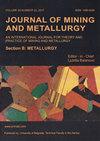Non-diaphragm electrodeposition of antimony: Effect of process parameters and precipitating agents
IF 1
4区 材料科学
Q3 METALLURGY & METALLURGICAL ENGINEERING
Journal of Mining and Metallurgy Section B-Metallurgy
Pub Date : 2022-01-01
DOI:10.2298/jmmb220129027m
引用次数: 0
Abstract
Metallic antimony production from antimony-bearing materials is a research hotspot. The conventional electrowinning technology of antimony is a challenging problem due to the sulfur compounds that come from both the ore itself and the leaching solution in the electrolysis system. The electro-production of antimony in modified non-diaphragm cells is of interest because of the high price and maintenance issues associated with diaphragm cells. A sulfur-based problem in non-diaphragm cells is the focus of this study, which investigates the effects of various salts on this problem and also optimizes antimony production conditions. Various salts (i.e., BaCl2, CaCl2, Ba(OH)2, Ca(OH)2) were used as a precipitating agent for the formation of insoluble salts (BaSO4/CaSO4 and BaSO3/CaSO3), Sb concentration, amount of NaOH and Na2S in the bath, electrowinning time, and temperature were investigated to optimize reaction parameters. The Taguchi experimental design was used to determine the effect of each factor on the Sb deposition. The phases and structures formed during electroproduction were identified with the help of various measurement techniques This study found that in the presence of 96 mM BaCl2, 45 g/L of Sb concentration, 100 g/L of NaOH, and 60 g/L of Na2S were the most suitable factors. It was found that 40oC was the optimal electrowinning temperature. This result also demonstrated that increasing concentrations of BaCl2 reduced specific energy consumption.锑的非隔膜电沉积:工艺参数和沉淀剂的影响
含锑材料制金属锑是一个研究热点。由于锑的硫化合物既来自矿石本身,也来自电解系统中的浸出液,传统的电积锑技术是一个具有挑战性的问题。由于与隔膜电池相关的高价格和维护问题,在改性的非隔膜电池中生产锑引起了人们的兴趣。非隔膜电池中的硫基问题是本研究的重点,研究了各种盐对这一问题的影响,并优化了锑的生产条件。以不同的盐(BaCl2、CaCl2、Ba(OH)2、Ca(OH)2)作为沉淀剂形成不溶性盐(BaSO4/CaSO4和BaSO3/CaSO3),考察了Sb浓度、浴液中NaOH和Na2S的用量、电积时间和温度等因素对反应参数的影响。采用田口实验设计确定各因素对Sb沉积的影响。研究发现,在96 mM BaCl2、45 g/L Sb、100 g/L NaOH和60 g/L Na2S浓度的条件下,电解过程中形成的相和结构是最合适的。结果表明,最佳电积温度为40℃。这一结果还表明,增加BaCl2浓度降低了比能量消耗。
本文章由计算机程序翻译,如有差异,请以英文原文为准。
求助全文
约1分钟内获得全文
求助全文
来源期刊
CiteScore
2.00
自引率
40.00%
发文量
19
审稿时长
2 months
期刊介绍:
University of Belgrade, Technical Faculty in Bor, has been publishing the journal called Journal of Mining and Metallurgy since 1965 and in 1997 it was divided in two independent journals dealing with mining and metallurgy separately. Since 2009 Journal of Mining and Metallurgy, Section B: Metallurgy has been accepted in Science Citation Index Expanded.
Journal of Mining and Metallurgy, Section B: Metallurgy presents an international medium for the publication of contributions on original research which reflect the new progresses in theory and practice of metallurgy. The Journal covers the latest research in all aspects of metallurgy including hydrometallurgy, pyrometallurgy, electrometallurgy, transport phenomena, process control, solidification, mechanical working, solid state reactions, materials processing, surface treatment and relationships among processing, structure, and properties of materials.

 求助内容:
求助内容: 应助结果提醒方式:
应助结果提醒方式:


